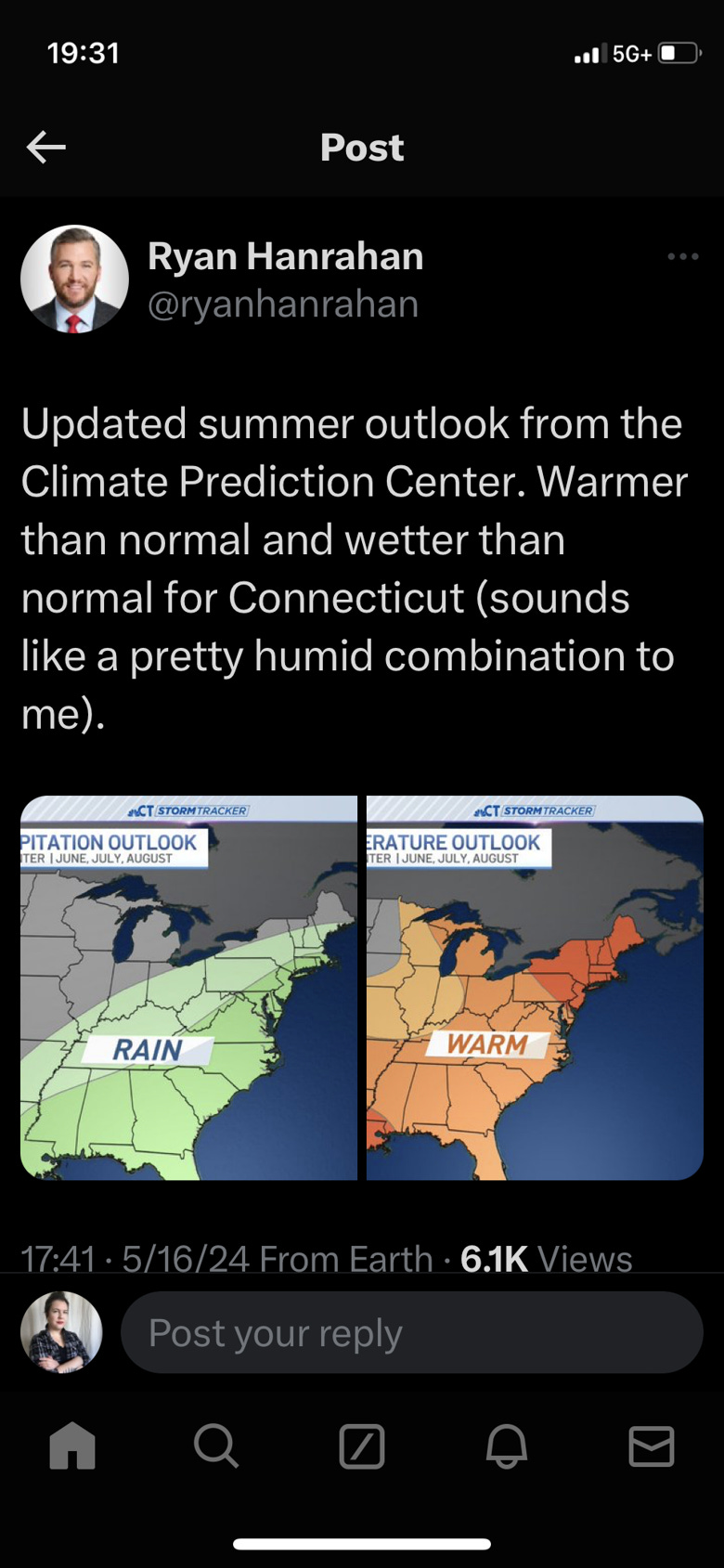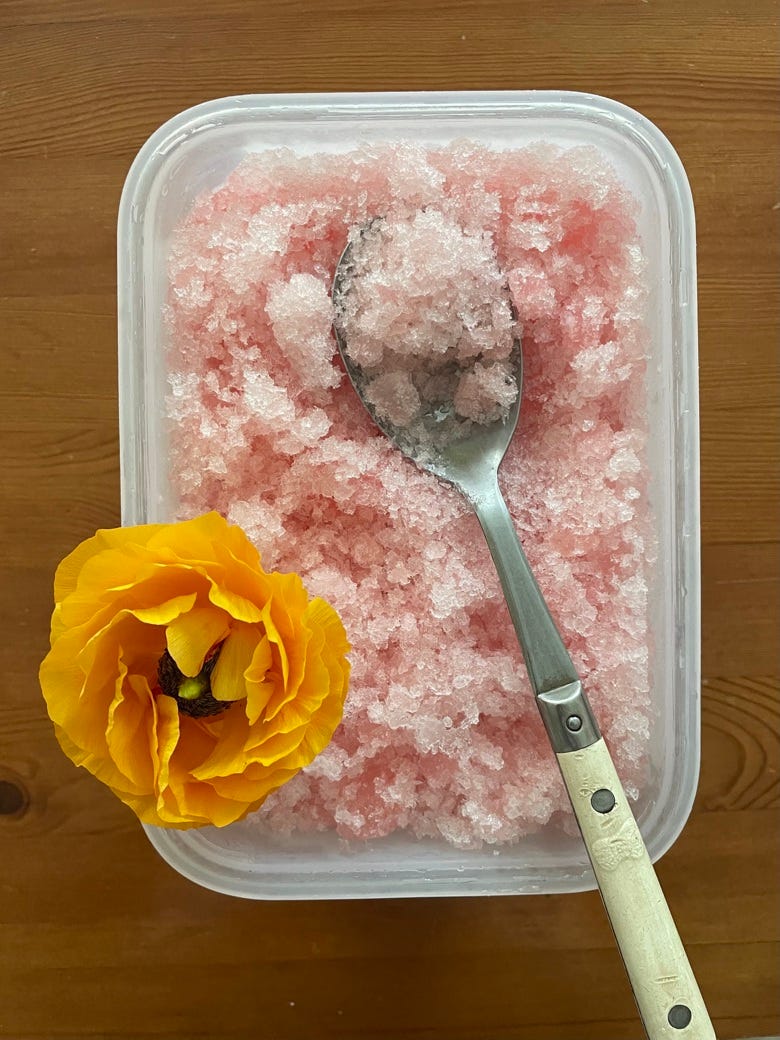Notes from the week* of May 13, 2024
*better title pending...
I'm going to get back to a practice of tracking/summarizing/commenting on what I'm reading, making, and thinking about each week. As a way of accountability for myself, as well as sending up a flare for fellow travelers.
This week I'm thinking about: what are we going to eat now that our regional climate is warmer and wetter; and how do we preserve food for year-round eating in a warmer, wetter climate. Also, implications of power outages for communication and food storage: dis*ster pr*paredness.
Connecticut has always had swampy, humid, summers, and a very healthy annual rainfall. But, where that was a wretched phenomenon mostly limited to summers, our winters are no longer consistently cold enough for much snow, and the sogginess is now year-round. On top of that, while we've lost the regular summer-afternoon-thunderstorm of my childhood (like Miami!), the rain and T-storms that do come through are much more intense, and we are on the tail end for Atlantic hurricanes zipping up the East Coast on the jet stream...
Ironically, our growing season hasn't changed drastically - gardeners and farmers can take advantage of the lack of a deep freeze with high tunnels and row covers, but for the average backyard gardener, the growing season is still only about 6 months of the year - 1 harvest. And for shoppers, especially food-assistance clients, accessing that fresh, local produce is a challenge - most farmers' markets here only operate about 5 months of the year - and they close when it rains...
The climate warming and weirding is also making our region more inviting to blights, invasive species, and regular growing challenges like (non-beneficial) fungus. Viz, the antibiotic-resistant apple blight spreading through orchards. (Sorry, paywalled link. Google 12 ft ladder.)
We had a few warm (~80F) and humid days this week, so I've been thinking about what I want to eat during swamp-ass weather which is right around the corner, lasting basically from June to September.
Growing up, my mom would make a big batch of cold tuna-pasta salad, with some chopped veggies and herbs mixed in. My dad would grill in the backyard. So we could mostly avoid turning on the stove on the hottest days. I'm finding all of this a challenge in a century-old, plaster-walled (no insulation) apartment in an urban heat sink.... the pasta salad gets tired, week after week on the menu.
A tidbit from the Chef's Table episode about Corrado Assenza and Caffe Siciliana stayed with me: granita and brioche for breakfast in the hot Sicilian summer.
This option obviously flies in the face of the nutritional caution against the sugary, carby breakfast (more protein!) but I think it's a good starting point to iterate from - protein-full spreads for the brioche, and add-ins for the granita.
We happened to have a jug of watermelon juice in the fridge that proved unpopular with the kid here, so I dumped it in a plastic tub, froze-and-scraped it for the afternoon, and lo, a very delicious and refreshing treat. We'll need to perfect our manual technique for achieving a consistent, scoopable ice crystal size, but it's easy and accessible - amazing what a phase-change can do to counter food waste.
A quick search for 'homemade granita' will get you started, but here's a decent set of instructions with nice options.
Brioche col tuppo is more involved, and does require an oven... but the dough is easy and fun to make, and there's an option to freeze them before baking. I'm going to continue experimenting with this, and refine a system to freeze the formed buns, so they can be baked one or two at a time in the toaster oven... Claudia at the Gourmet Project says it can be done. Recipe here (you'll need to convert the measurements).
Basically, I'm looking to hotter, humid regions for inspiration on what to grow, what to eat, how to preserve an abundant harvest...
I also came across a couple of articles on Low-Tech Magazine about fermentation, and the food system in Vietnam - a hot, damp climate if there ever was one.
Aaron Vansintjan reminded me how fun fermented foodcraft is, and also gave me a deep dive into fermented foods in Vietnam. In the pre-vaccine period of the Covid pandemic, I had delved into making kombucha and sima in my kitchen cupboards. There were also pickled citrus condiments, and thieves' vinegar for cleaning. I eventually gave up on my kombucha and ate the mother as a snack, because no one else in my household was a fan.
But I never got into sourdough bread, so this week I started my very first... starter. Still a work in progress. The recipe from King Arthur Flour is very thorough and generous, and I was delighted by their jab at the sourdough gatekeeping grifters of the internet...
I teach backyard composting, which my colleagues and I sometimes describe as "farming bacteria" - and I'm realizing that, while fermentation is anaerobic vs. aerobic composting, it's similar in that we, the human participants, have to consistently tend the bacteria and their environment to help them do what they do best... rot n' roll...
Also tested my 20-year-old memory of making perpetual yogurt at home, as taught to me by my college friend's mom, a phenomenal Indian cook. So far, I haven't gotten it right, but I'll keep trying. I can't even eat dairy anymore, but my roommates do, so it's worth the effort.
So that's food, which is fun and tasty and an accessible entry point to up-skilling for the climate apocalypse. But I'm still out of my depth and wondering about off-grid energy and communications, and how I might share those tools and skills with other renters…



